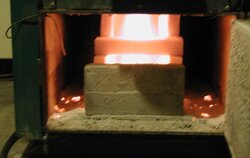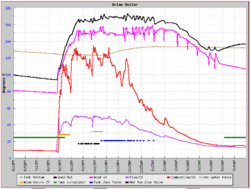I had a PM asking about my secondary combustion thermocouple. I decided to post a picture showing the installation as well as secondary combustion roaring along.
Sorry about the focus - the camera has a very hard time in this situation.
The thermocouple is an Omega stainless jacketed model with an ungrounded tip and a 1/8" diameter sheath. It's inserted through a 1/8" diameter hole drilled in the flange that the door seals against. It's bent back so that it's in the secondary chamber far enough to be useful, and clears the door refractory.
At the time this photo was taken, the thermocouple registered about 1400 F. As you can see, the actual combustion zone is just a bit hotter than that ;-)
Sorry about the focus - the camera has a very hard time in this situation.
The thermocouple is an Omega stainless jacketed model with an ungrounded tip and a 1/8" diameter sheath. It's inserted through a 1/8" diameter hole drilled in the flange that the door seals against. It's bent back so that it's in the secondary chamber far enough to be useful, and clears the door refractory.
At the time this photo was taken, the thermocouple registered about 1400 F. As you can see, the actual combustion zone is just a bit hotter than that ;-)



